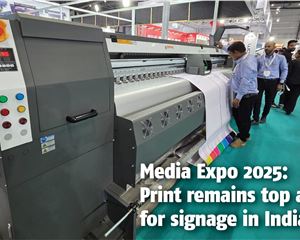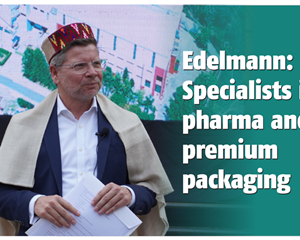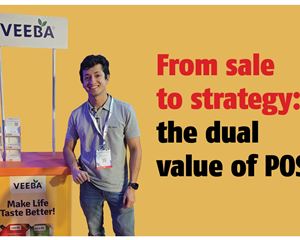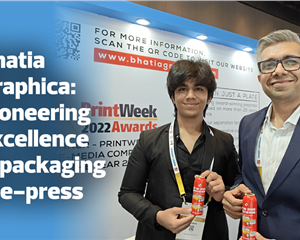Why is Goss web-focussed at Labelexpo Europe?
In an in-depth interview with PrintWeek India at Labelexpo Europe, David Muncaster, Goss International director of business development for packaging, discusses why the show is important for Goss, why film and clear substrates are maintaining better growth rates in India and the challenges and threats the Indian label segment is facing, among others.
24 Sep 2013 | By Noel D'Cunha
PrintWeek India(PWI): How many Labelexpos has your company participated in? What will you showcase at the show? Launches? Highlight of the stand?
David Muncaster(DM): This is the first ever Labelexpo for Goss and as such it recognises the massive potential we see for web offset in enabling packaging printers to produce shorter run lengths economically. We are showcasing these benefits and in particular the capability of the SundayVpak to print a range of labels and flexible packaging applications.
PWI: Why is it important for you to exhibit at Labelexpo Europe 2013?
DM: Label Expo is a major show on the packaging calendar attracting a wide variety of people from within the packaging market in Europe and far beyond. It’s not only a show focused on labels, but also on flexible packaging which is currently the fastest growing sector in packaging printing – so, it is of great interest to many existing label printers looking to expand their business portfolios.
As well as an ideal place to meet with potential customers and end users, Labelexpo also serves as an excellent networking event. As a manufacturer, you can meet many ancillary equipment and consumables suppliers, potentially leading to new partnerships or technical discussions with the ultimate aim of bringing further benefits to customers.
PWI: What are your expectations from the show?
DM: We truly believe the time is right for web offset in this industry and we expect that there will be a building momentum behind that fact at this show. We really want to spread the word about the inherent advantages of web offset to converters and to printers who may never have considered it before. Web offset in packaging printing is mistakenly viewed by many as being essentially like sheetfed offset but wider and faster, but this couldn’t be further from reality. The web tension expertise involved in the design of Goss presses makes it ideal for printing to very fine films, and the ability to incorporate ancillary devices inline - e.g. flexo stations, gravure stations and a wide range of inline finishing systems – is also a major differentiator.
Labelexpo Europe is also the key event for seeing and learning about all the latest developments and trends in the market so it’s an essential date in the diary for suppliers and manufacturers to the industry.
PWI: From an Indian perspective, what should the Indian label manufacturer look forward to at your stand?
DM: Goss can discuss with them opportunities for increasing - or gaining better control of - margins through introducing more production efficiency and greater flexibility in substrates, consumables and applications. Goss technology also offers Indian label printers and converters the opportunity to more easily differentiate their product offering to customers, by making shorter runs more viable; this in a country where short-run definitely does not mean on the ‘micro’ scale that digital printing caters for.
PWI: What are the factors driving growth of label industry in India? What are the threats?
DM: India has seen huge growth in all areas of packaging due to rapid changes in its demographics and consumer expectations. Although growth has slowed down, labels produced on film and clear substrates are maintaining better growth rates, perhaps due to their greater aesthetic appeal and ability to sell a brand. As consumer expectations become more sophisticated, web offset is in the enviable position of being able to produce unbeatable print quality with lower cost consumables and faster turnarounds.
The threats for the Indian label printing industry must surely be the fluctuating currency and the cost of the specialised consumables, which are predominantly imported from abroad. These things make it very difficult to achieve pricing stability and trade beyond the domestic market.
PWI: There is great deal of on-going research and development in the label manufacturing sector, so how should a prospective buyer zero-in on a certain technology? What technologies will play a major role in the near future?
DM: These are always difficult considerations in any industry: How do you assess which will be the technology that really develops to full potential, and when is the right time to invest? It takes real courage and vision to adopt a completely new technology, and usually there are many teething problems along the way.
For prospective buyers, the most useful advice I can offer is that they should really take time with their customers – not just respond to their demands, but to try and understand the drivers in their business and how they see their markets developing. Which technologies on the market are going to be able to adapt to those developments over the next five+ years?
Of course I’m going to say that for packaging printers/converters who deal in high-volume flexo or gravure and who are experiencing demand from customers for more design variants in shorter run lengths, web offset is the ideal solution. In the case of Goss web offset, not only does it provide the ability to make a viable business out of fulfilling these requirements, but it is also proven technology in use every day all over the world.
PWI: Label converters strive to reduce production operation costs while continuing to bring innovation and value to their customers. Discussions with label converters show a common need for production flexibility. Do you have machines or products that address these concerns of an average label converter?
DM: This is the very reason we are exhibiting at Labelexpo Europe this year. Production operation costs can be reduced very effectively by using lower-cost consumables and by shrinking makeready time and waste to a minimum, while maintaining repeatable high-quality standards.
The Goss Sunday Vpak is far more capable than flexo or gravure to address short leadtimes and run lengths. It offers the high productivity and fast, low-cost plate production and makereadies common to web offset production, as well as providing the flexibility to print solids and screens from one plate at high speeds on to a wide variety of substrates, including films as fine as nine microns.
Quite unique to the Goss Sunday Vpak series of presses builds is its innovative variable sleeve technology featuring quick-change blanket and plate cylinder sleeve adapters that make ‘infinitely’ variable repeat lengths even easier and more affordable.
With options for integrating flexo, gravure and digital stations into a Vpak press configuration to form a hybrid production line, it delivers flexibility without compromise as printers continue to benefit from a wide range of coating and finishing options.
PWI: Given the present currency crisis, do you expect business from Indian label printers? How would you make things easy for those travelling to Labelexpo Europe with investment intentions?
DM: In reality, this is a very difficult time for Indian printers who source any part of their supply chain from outside the domestic market, but the situation will improve and that also means there are opportunities to get a headstart on the competition. Goss International is always interested in discussing innovative solutions to any problem.












 See All
See All